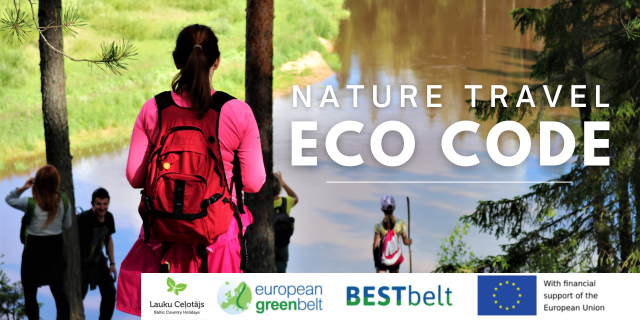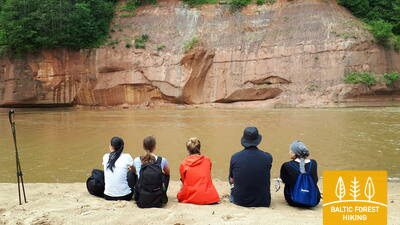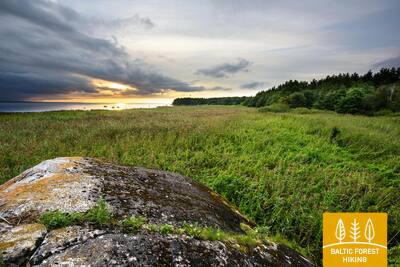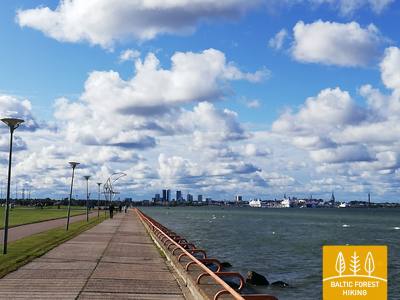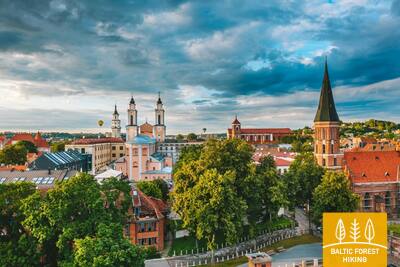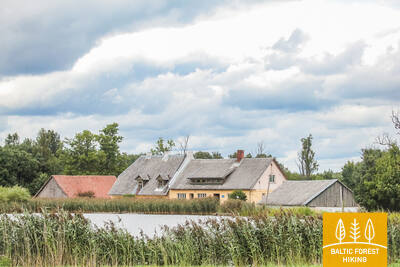Baltic Forest Hiking - City hikes
 Section 1. Old Riga - Baltezers.
Section 1. Old Riga - Baltezers.
Through Riga – UNESCO World Heritage Site
The starting point of Forest Trail in Latvia is located in the heart of Old Riga, the Town Hall Square. The route leads along Kaļķu Street, passes the Monument of Freedom, through Vērmane Garden and along the historic Tērbatas street. Then it arches over the Zemitāni railway station pedestrian bridge and treads into Biķernieki and Šmerlis forests. The Forest Trail winds through Jugla, passes the Latvian Ethnographic Open-Air Museum and goes on along the pedestrian-bicycle path until Baltezers.
 Section 6. Līgatne - Cēsis.
Section 6. Līgatne - Cēsis.
Along the old Cēsis road through the valley of Amata River
One of the most scenic parts of the Forest Trail stretches along the historic village of the Līgatne Paper Mill, passes Spriņģi Rock, curves along Skaļupe Trails and the Mythological Trail, stops at one of the most secret sites on this side of the Iron Curtain, the Soviet Bunker, then continues along Roči Nature Reserve, crosses Amata (the most beautiful and rockiest part of the river) and finally comes to Zvārtes Rock. Next, the Forest Trail runs along the high banks of Amata valley and follows the historic Cēsis–Riga “highway” (now a small rural/forest road with old mileposts) to Rakši, then ascends up the Vāļukalni hills and Ozolkalns, following along the River Gauja until it meets Cīrulīši Nature Trails. It comes to a stop at Gaujas street, but travellers may continue down the path for a further 2.8 km to Cēsis, spend the night there, and continue walking on the following day.
The historic center of Cēsis, with the ruins of the Livonian Order Castle, the New Castle, St. John’s Lutheran Church, its small streets, the Cēsis Museum, and many cultural and historical monuments, is an ideal setting for local hikes. It offers an opportunity to explore local traditions, various annual events, culinary heritage, and more.
 Section 39. Mahu‒Kunda.
Section 39. Mahu‒Kunda.
Experiencing the Kunda industrial heritage
From Mahu to Letipea village, the Forest Trail runs along small coastal roads close to the sea and along the coastline for a stretch of road. It may be worth taking a 2 km detour (there and back) to the Ehalkivi Boulder. For the next three kilometres from Simunamäe, the Forest Trail leads along the foot of the North-Estonian Klint, which is covered by a primary forest. The coastline is about a kilometre away from here. Information boards about the history of Kunda have been placed in the territory surrounding the Lontova manor. You can also visit the many objects located in the city and along the river that are related to the historical development of the city cement plant.
 Section 50. Püünsi‒Tallinn.
Section 50. Püünsi‒Tallinn.
Most beautiful sights of Old Tallinn
The Forest Trail passes by the Gulf of Tallinn, and beautiful views of the towers, harbour and skyscrapers of the city can be seen as early as in Püünsi. The Forest Trail turns into a beautiful pine forest before Pirita, then follows along a sandy beach for 2 km. Behind Pirita all the way to the Port of Tallinn, the Forest Trail takes you along the beautiful city waterfront promenade, which overlooks the city’s most important cultural and historical sites, and offers beautiful views of the sea and the port. The final destination of the Forest Trail is located in the Port of Tallinn, next to the Old Town. You can spend another day or two visiting various tourist locations of Tallinn.
 Section 63. Vaišvydava – Kaunas.
Section 63. Vaišvydava – Kaunas.
Through Kaunas parks
From the Kaunas Lagoon Regional Park Visitor Centre, the Forest Trail leads through the Rokų forest and along the Miškininkų, Kelmyno, Muraškinės, Žarstos, Garšvės and Rokelių streets, circles the Kaunas suburbs, crosses the Marijampolė road (No. 139) and continues in the direction of Balčkalnio street to Panemunė district. At the stadium of Kaunas University of Technology Engineering Lyceum, it descends to Vaidoto street, then continues along the sidewalk to Baterijos highway, where it turns left. About a third of Kaunas city area is occupied by parks and other nature territories. The Forest Trail crosses the city through its greenest parts. About 2.5 km long the Forest Trail passes through the Panemunė pinewood, which has a dense network of trails, recreation areas and a beach. The Forest Trail crosses the Nemunas along the Three Virgin Bridge, leads through Gričiupis district, runs along Kaunas Zoo, crosses the vast Oak-Wood Park (Ąžuolynas) and leads through Vytauto Park behind the Lithuanian Sports University. Down the park stairs, the path descends to the beginning of the Avenue of Freedom (Laisvės Alėja) and continues to the destination of the section in Kaunas center.
IMPORTANT. There are no markings where itineraries are crossing the territory of Kaunas city.
 Section 64. Kaunas – Lampėdžiai.
Section 64. Kaunas – Lampėdžiai.
Through the historical centre of Kaunas
Kaunas is the second largest city in Lithuania. The 1621 m long Avenue of Freedom (Laisvės Alėja) stands out for its unique modernist architecture – its 1914–1940 buildings has received the European Heritage Label. Vilniaus street is the “gateway” to the medieval city of Kaunas, run by Hanseatic merchants. The Forest Trail runs along Avenue of Freedom (Laisvės Alėja), crosses the Old Town of Kaunas with churches, the Town Hall Square and historical buildings, and throws a circle along Confluence Park (Santakos parkas), where Lithuania's largest rivers, the Nemunas and the Neris, meet. After crossing the Neris river, the Forest Trail continues along the footpaths and bicycle paths to the 4 km distant former Lampėdis gravel quarry, which is flooded and now is a popular place for recreation and swimming.
IMPORTANT. There are no markings where itineraries are crossing the territory of Kaunas city.
The city's historical center, old town, and the Nemunas riverbanks with promenades are suitable for short or longer urban walks, including during nighttime, as well as for photo and video sessions. At the end of the section, there are former gravel quarries, which have been turned into a recreational area.
 Section 92. Snēpele – Kuldīga.
Section 92. Snēpele – Kuldīga.
Venta valley and Riežupe Nature Park
Along the main street of Snēpele, the Forest Trail takes the road V1294 and after 0.3 km opposite Ķepšu lake turns right onto a small country road. Along this road, the Forest Trail bends to Slipiņciems, before crossing Sprincupe along the dam, where a pond has been created. Then the Forest Trail goes in the direction of Pelči. Nearby Pelči, the trail bends along Pelču Dambu ponds, leads to the Kuldīga–Pelču road (V1293) and further stretches through the Kuldīga garden areas – “Kurzemīte” and “Rumba”, until it reaches the Venta bank and the Kuldīga bypass. From there to the Old Brick Bridge, the Forest Trail for 2.4 km leads along a beautiful Venta coastal path, where there are wooden bridges and footbridges in wetter places and across streams town of Kurzeme.
The historic center of Kuldīga (UNESCO), with its churches, residential and farm buildings, architectural elements (like light windows), the banks of the Alekšupīte river, and a unique offer to wade through the small river that flows through the town center between buildings with rubber boots, the old brick bridge, the Venta waterfall, and more.
 Section 102. Bulduri - Riga City Center.
Section 102. Bulduri - Riga City Center.
Through the Forests To Riga
The itinerary is an alternative way to get from Jūrmala to Riga by going through the forest. After passing the bridge across the Lielupe River, the Baltic Coastal Hiking Route snakes through Priedaine with its wooden buildings, goes along the right bank of the Lielupe River, then turns towards the Southern part of Bolderāja Dune and crosses Kleisti forest past Lāčupe Cemetery. Next, it goes along the historic roads of Pārdaugava on the West bank of the Daugava River, namely, Buļļu and Daugavgrīvas iela, through Dzegužkalns Hill, passing the Zunda Canal and Āgenskalns bay until reaching the Daugava River, which the route crosses via the Stone bridge and then stops at Town Hall Square.
An interesting stretch between Jūrmala and the central part of Riga: the historic buildings of Priedaine, the Spilve meadows, and the Kleisti forest with sites of Latvian riflemen battles from World War I, the Pārdaugava district, the former industrial zone of Iļģuciems (19th-20th centuries) with Dzegužkalns, the Zunda waterfront, the buildings and museums of Ķīpsala, Āgenskalns Bay, and the bridges over the Daugava as industrial heritage sites.









